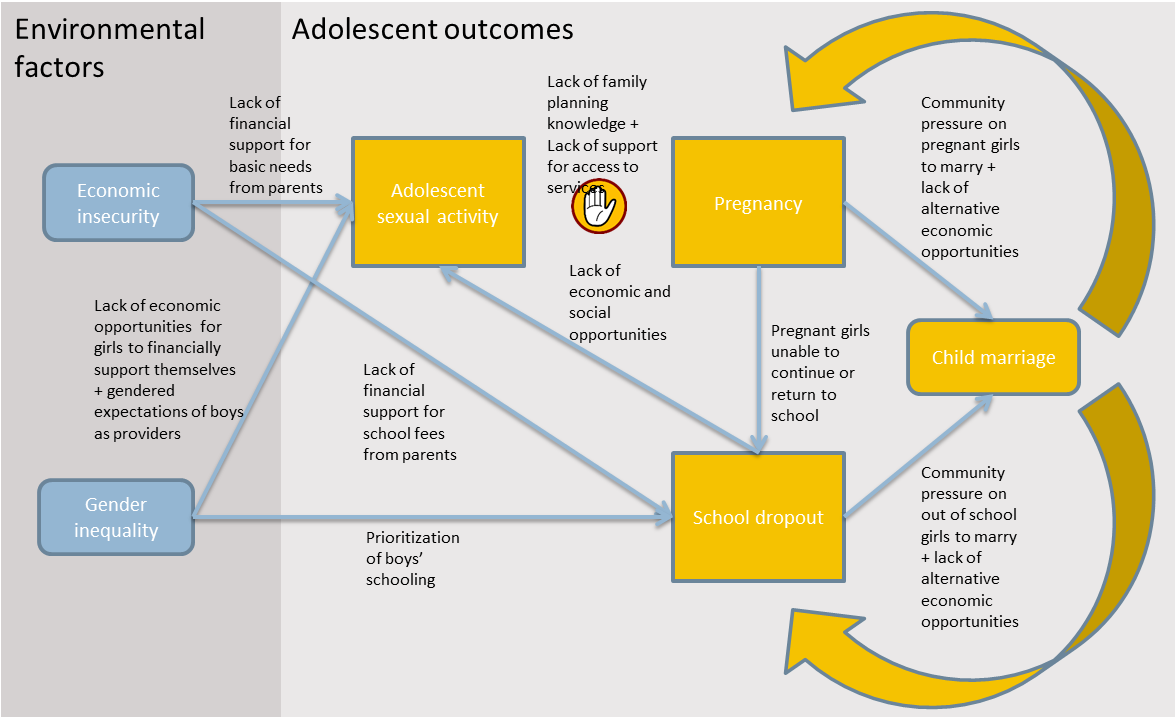When researchers for the Washington, D.C.-based International Centre for Research on Women (ICRW) spoke to people in rural Kenya and Zambia about their views on child marriage, they heard a range of reasons for why a girl might get married before she turns 18, from financial necessity to tradition. “She has not gone to school for long, so she cannot wait that long for the right age to get married,” said one mother. “She cannot just sit around waiting to turn 20.”
Working alongside local partners Plan International Zambia and Kisumu Medical Education Trust (KMET), the ICRW researchers gathered everything they had learned into a study about the drivers behind child marriage in the two countries. Published in September, the study, which adopted that Kenyan mother’s phrase for its title, “She Cannot Just Sit Around Waiting to Turn Twenty,” centers around a comprehensive map that outlines the various pathways to child marriage and ways of disrupting them. Of all the pathways the study looks at, researchers have pinpointed the two most direct precursors to early marriage: dropping out of school and teen pregnancy.
The 2014 statistics from the Demographic and Health Surveys for Kenya and Zambia show the extent of the problem. In Kenya and Zambia, the figure for women between the ages of 20 and 24 who were married before their 18th birthday stands at 20.3 percent and 31.4 percent respectively. In that same age group, less than 24 percent of women in Kenya finished high school and only 16.7 percent in Zambia, while the rate of those who gave birth before they turned 18 is 20.3 percent in Kenya and 30.7 percent in Zambia.
ICRW’s Mara Steinhaus, who co-authored the report, says the report picks up from previous research that revealed differences between the drivers of child marriage in sub-Saharan Africa and in South Asia. “In general, such work has shown that adolescent sexual activity prior to marriage is much more common in sub-Saharan Africa and thus a much more important driver of child marriage as compared to in South Asia,” she says.
The study is not all bad news. ICRW researchers have identified interventions for each of the pathways to early marriage, including improving intergenerational communication; addressing barriers to adolescent sexual and reproductive health and family planning access; overcoming barriers to accessing education; and addressing inequitable gender norms.
“Every arrow in the diagram represents a pathway that can be disrupted,” says Steinhaus. “For example, if we can break the link between adolescent sexual activity and pregnancy by providing youth-friendly reproductive health services and increasing knowledge about family planning, we can expect to see reductions not only in pregnancies, but subsequently in child marriage and school dropout as well.”

Steinhaus says it would be best to carry out the interventions at the policy level, where they have the best chance of altering broader socioeconomic factors such as financial insecurity and gender inequality – factors that sit at the start of the pathways. But the map is designed to show the various ways different types of stakeholders can become involved in tackling adolescent pregnancy, school dropout and child marriage, illustrating that interventions at any point along the pathways can have a positive effect.
Steinhaus points to several evidence-based programs in Kenya and other countries that have been effective in blocking the roads that so many girls take to early marriage. Programs like Families Matter! in Kenya, which focuses on promoting positive parenting and parent-child communication, and the Gender Equity Movement in Schools (GEMS) program in India and Uganda’s SASA! program, both of which aim to improve gender norms and relationships, should serve as inspiration to other organizations looking to help girls avoid marriage until they are ready, she says.
According to KMET spokeswoman Brenda Achieng, the organization currently has two key programs that are aimed at disrupting the pathways that ICRW identifies in its study. Sisterhood for Change is a vocational training program targeting vulnerable girls and girls that have married early. The program provides them with vocational training in tailoring, beauty and catering as a means of helping them support themselves and their families, so they don’t feel the financial pressure to get married.
KMET also runs a safe space program for girls, which includes the provision of youth-friendly sexual and reproductive health (SRH) services, SRH education in schools, and youth centers that give girls somewhere they can go for support and advice.
Plan International’s Lazerus Mwale, spokesman for their regional office in Zambia, says the organization is using the research findings to refocus its work on eliminating gender inequality and to design new initiatives under its Because I Am a Girl (BIAAG) Movement and 18+ Program, including a youth business course to combat economic insecurity and educational programs through theater and radio to promote gender equality.
And its success could soon have a further reach. Plan International has managed to engage the Southern African Development Community-Parliamentary Forum (SADC-PF) and the NGO played a supporting role in the development of an SADC Model Law on Eradicating Child Marriage and Protecting those Already in Marriage. The model law will become an SADC Protocol on Adolescent Health and Child Marriage, which will be binding in all 14 SADC member states.
In any move to disrupt the pathways to child marriage, KMET’s Achieng stresses the need for a holistic approach. “We really have to change policies on integration because you find that the programs implemented by national government and other organizations are not integrated,” she says. “For example, they may focus on empowerment programs but they are not cognizant of other socioeconomic factors in the environment that put girls at risk of early child marriage.”
